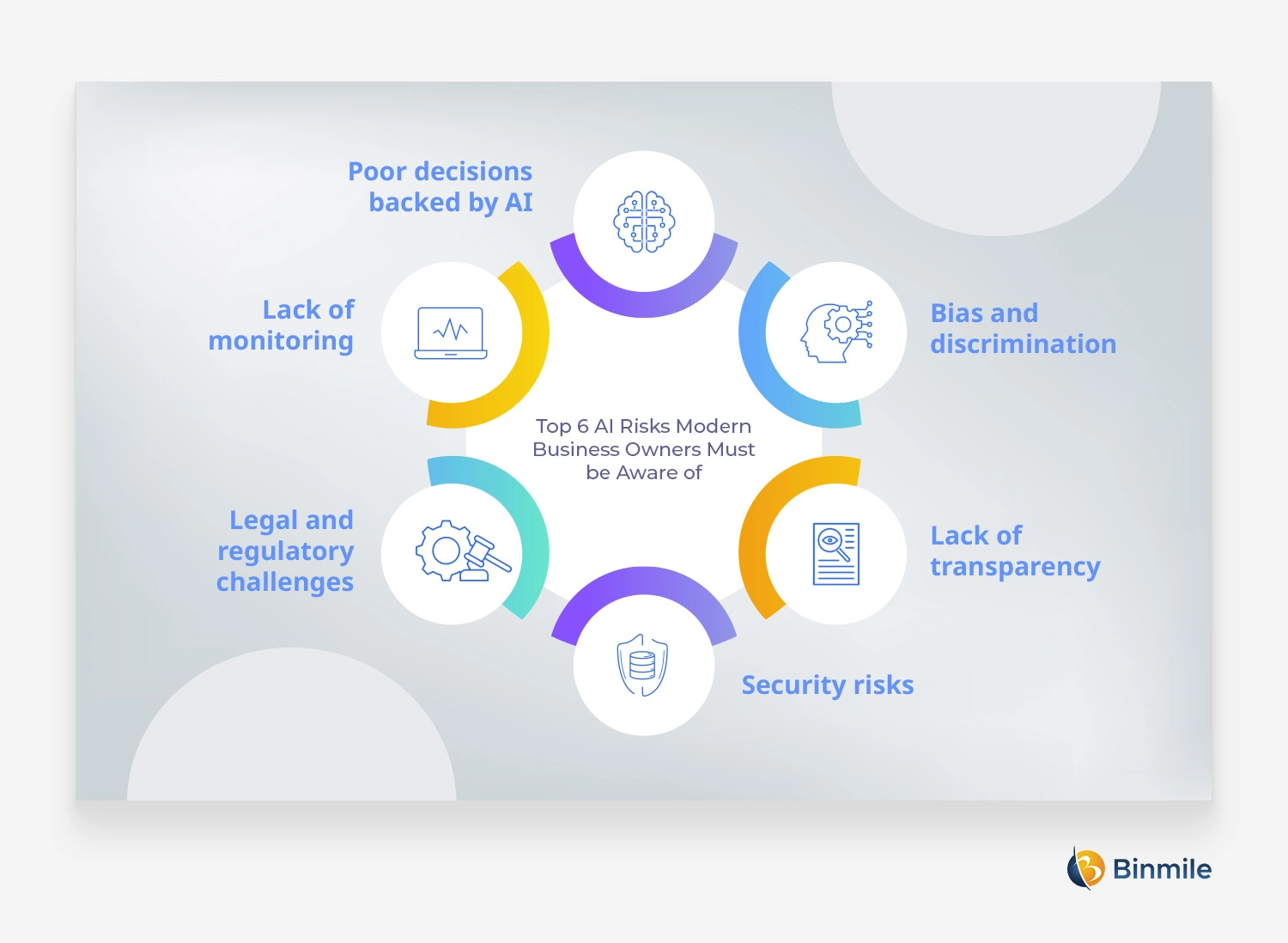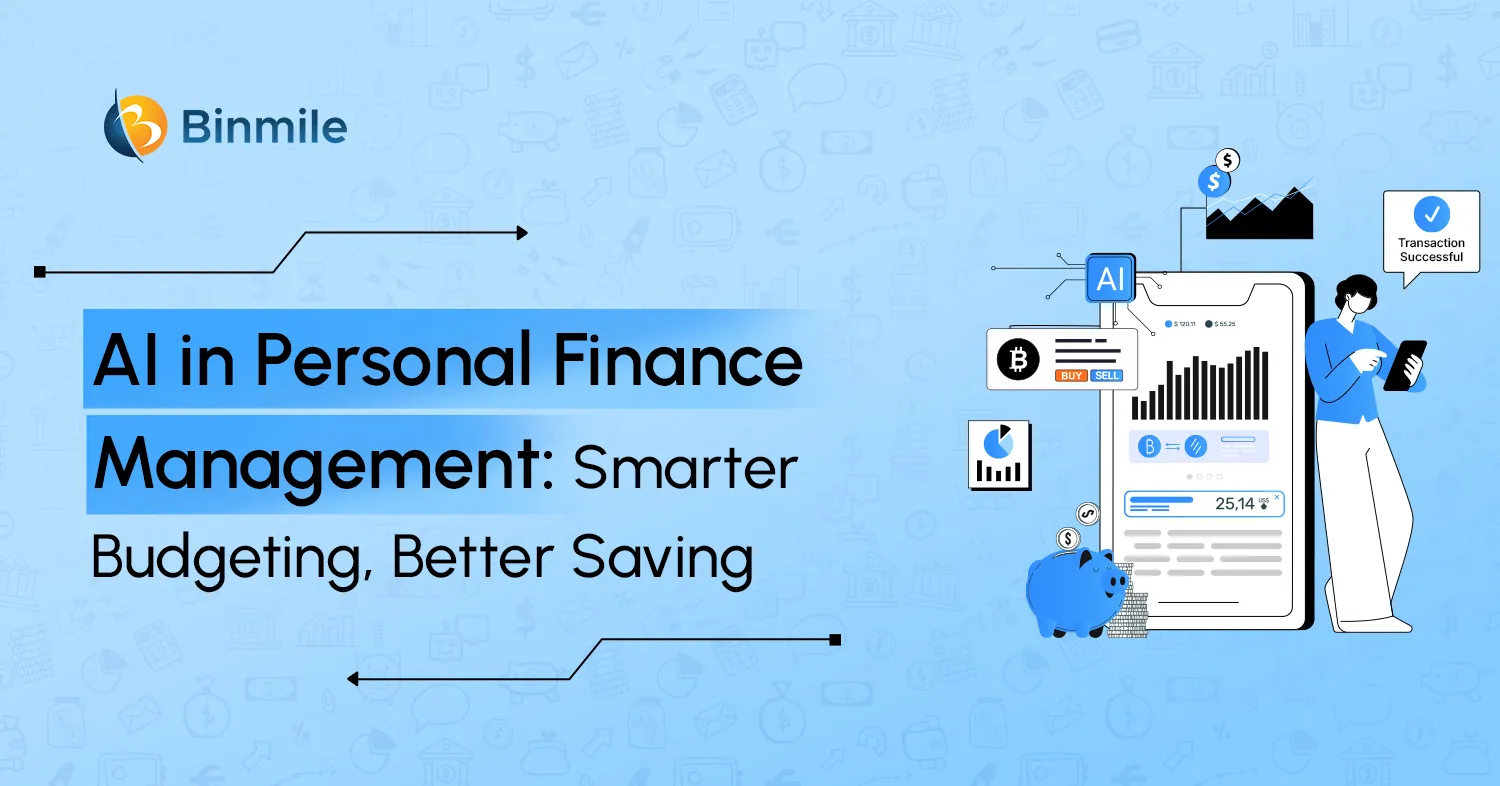Planning to adopt AI is a big decision for businesses that are considering reaping its benefits. Yes, AI implementation doesn’t just come with pros but some cons as well. Take, for instance, a myriad of companies that can utilize AI to automate tasks that don’t require high-end skills. However, AI can’t be fully relied on when it comes to making instrumental business decisions. There are chances that this cutting-edge technology can wrongly interpret the information and produce erroneous outcomes. Not just that! There are many more Artificial Intelligence risks that businesses may face if unaware of the techniques required to resolve emerging AI challenges.
For this reason, today we have decided to shed light on some lesser-known AI risks and solutions that could greatly benefit establishments.
Read Also: Enterprise AI Solutions
Top 6 AI Risks Modern Business Owners Must be Aware of

1. Bias and discrimination
AI systems can maintain societal biases to a great extent depending on the data sets they are trained with. This particular trait of AI could result in the:
- Biased decision-making
- Discrimination
- Unfair behavior toward certain groups
Solution:
To sort out such AI risks, firms must focus on investing in diverse and representative training data that they can analyze effortlessly. That’s not all! It will also help if concerned agencies implement bias detection and correction algorithms and remember to perform regular audits of AI models. This way, it will become a cakewalk to identify and eliminate the bias issues from the current AI systems.
Every business owner must set fairness and impartiality as their core principles to support Ethical AI development.
Also Read: Ethical AI Development Models
2. Lack of transparency
In multiple cases, AI systems have been found operating in a non-transparent manner. This is something that makes it difficult to perceive how AI-powered models take several plunges. What’s more? Such transparency-related issues can translate into distrust among users and stakeholders according to a top AI development company.
Solution:
When fixing this issue, corporations must prioritize transparency by fabricating AI models and algorithms that help offer deeper insights into their decision-making methods. This task can be made extremely easy with the use of:
- Clear documentation
- Explainable AI techniques
- Some tools to visualize AI-powered results
Be mindful, that transparent AI plays a key role in improving the overall trust among different parties and their decisions and assists in regulatory compliance as per the best digital transformation services provider.
3. Security risks
As the implementation of AI technology is growing in every field, so are security risks. The worst part of Artificial Intelligence risks is that some fraudsters can call on AI systems to construct more hazardous cyberattacks that can become a serious threat to businesses.
Solutions:
It will pay off if entities implement strong security measures to lower security risks, such as:
- Authentication protocols
- Encryption
- AI-backed threat detection system
Please remember, that conducting ongoing monitoring as well as regular vulnerability checks can come in handy in protecting the deployment of AI systems under a custom software solutions provider.
4. Legal and regulatory challenges
Recently, AI has brought in fresh legal and regulatory complexities, including the problems related to liability and intellectual property rights. And it is immensely important for legal frameworks to evolve so that they can align well with newer technological advancements.
Solution:
The best way to deal with such AI risks is to remain informed about AI-related regulations and actively converse with policymakers to develop accountable AI governance and practices. Apart from this, interested business owners can tap AI for risk and compliance solutions when they need to analyze a sizeable amount of information during the identification of feasible compliance-associated risks.
5. Lack of monitoring
If you remember well, Microsoft launched a chatbot named Tay on X (formerly Twitter) in the year 2016. The software developers at the tech giant had manufactured the bot to participate in online interactions and get the hang of different patterns of language. According to a leading AI risk management company, the main goal of Tay was to imitate the speech of a female teenager so that she could sound natural on the cloud.
Instead, trolls made the chatbot learn racist and misogynistic language that resulted in her offensive behavior within a couple of hours. As a result, Microsoft suspended the account with immediate effect to not let such AI risks grow further.
Solution:
To avoid big risks with making and tapping AI, business owners must teach AI models well enough to work in the right fashion.
6. Poor decisions backed by AI
An incident we must highlight here is that when the shooting took place at a private Nashville school in 2023, the Peabody Office of Equity, Diversity, and Inclusion at Vanderbilt University responded to this event quite casually. Yes, the concerned authority had used the ChatGPT tool to prepare the message, and the same was mentioned at the end of the email. The very next moment, students and other fellows condemned the use of technology in such a situation, making the university apologize for poor judgment.
Hence, this event indicates the AI risks organizations can come across when using tools driven by Artificial Intelligence technology. The way an entity decides to take advantage of such state-of-the-art technologies could influence how different individuals view them, be it their customers, partners, employees, or even the general public.
Solution:
When developing an AI tool or application, please make sure that your creation doesn’t produce biased, invasive, manipulative, or unethical results by screening the concerned AI system time and again. Keep in mind, if you don’t take such suggestions seriously, the finest AI risks management firm says it can change the image of your brand in a way that you won’t wish to.
BONUS:
7. Low return on investment
The potential of every technology is eventually determined by its return on investment, also known as ROI. The topmost AI risks management agency states some technologies have been invented with solid promise but they failed owing to higher cost of usage than required for production. A few cases in point here are:
- Google Glass
- Segway
- Betamax
- Fuel-cell technology
All these technologies either failed or didn’t generate expected market gains. Also, in Zillow’s case, their misguided attempt to implement automated purchases of homes supported by an AI-driven pricing algorithm led to the failure of AI in terms of ROI. Instead, the company suffered a humongous loss in multiples of millions of dollars as per a pre-eminent AI development company. A study by a consulting firm and a school of management collectively revealed that only 11% of organizations say they experience a significant ROI post-AI use.
Solution:
It is a smart decision to turn to a prominent Artificial Intelligence risk management entity before you decide to integrate AI into your important business processes. Yes, they will guide you in the best possible way to leverage Artificial Intelligence technology without disrupting your core processes.
Also Read: AI in Healthcare: Challenges to Regulations
Summing-up
There is no denying the fact that AI use is advantageous for businesses, but it can benefit interested establishments only when it is taken into use wisely, ethically, and properly. Bear in mind, that there have been wads of cases where businesses have saved hundreds of thousands of dollars by utilizing AI for their key work execution. But in some cases, AI has also been found to tarnish the reputation of institutions due to quality concerns. Thus, the entire tale concludes at the point that if you want to make the most of AI to boost your organizational productivity and efficiency, first consult the representatives of a long-standing AI development company and pick their brains on how to execute the job.
Frequently Asked Questions
AI risks refer to the potential negative consequences associated with the development, deployment, and use of artificial intelligence (AI) technologies. These risks encompass various concerns, including bias and discrimination, privacy violations, security vulnerabilities, job displacement, ethical dilemmas, lack of transparency, and social manipulation. Addressing AI risks requires proactive measures to mitigate biases, enhance transparency and accountability, safeguard data privacy and security, and promote responsible AI development and deployment.
To mitigate AI risks, organizations can implement several measures, including:
- Bias Detection and Mitigation: Employing techniques to detect and mitigate biases in AI models, such as data preprocessing, fairness-aware algorithms, and diverse training datasets.
- Transparency and Explainability: Enhancing transparency and explainability of AI systems to understand how decisions are made and to identify and address potential biases or errors.
- Ethical Guidelines and Governance: Establishing ethical guidelines, regulatory frameworks, and governance structures to ensure responsible AI development, deployment, and use.
- Data Privacy and Security: Implementing robust data privacy measures, encryption techniques, and cybersecurity protocols to protect sensitive information and prevent unauthorized access or breaches.
- Human Oversight and Accountability: Integrating human oversight and accountability mechanisms into AI systems to ensure human intervention, oversight, and recourse in cases of errors, biases, or unintended consequences.
- Education and Awareness: Educating stakeholders about the risks and benefits of AI technologies, promoting digital literacy, and fostering a culture of responsible AI use and ethical decision-making.
The type of organizational risk related to AI that involves harm to brand or image is often referred to as reputational risk. This risk arises when AI systems or decisions made by AI algorithms result in negative consequences that damage the organization’s reputation, brand perception, or public image. This can occur due to incidents such as biased AI outcomes, privacy breaches, security incidents, or ethical controversies associated with AI deployment. Reputational risks can have significant impacts on customer trust, investor confidence, and stakeholder relationships, potentially leading to long-term damage to the organization’s credibility and market position. It is essential for organizations to proactively manage reputational risks by prioritizing transparency, accountability, and ethical AI practices in their AI initiatives.









